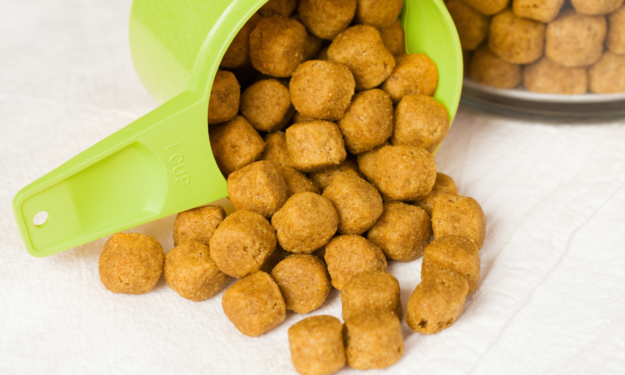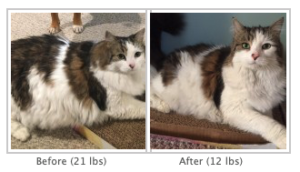How to Help a Dog or Cat Lose Weight – 6 Tips!

Written by Samantha Houde
The beginning of a new year is the perfect time to assess your pet’s weight! It’s colder and here in the Northeast, it’s full-blown winter which means your pet is probably a bit less active. This can often lead to some extra weight which over the years, builds up to an increase in body fat that may not be ideal for your pet.
Are you unsure if your pet could benefit from weight loss? We got you covered! We’re here to help you through your pet’s weight loss journey!
How do I know if my pet is the correct weight
Tip #1: Count calories
Just like with humans, the key to weight loss is calories in versus calories out! Often we find ourselves reading the back of the bag to determine how much to feed. However, these charts don’t take certain things into consideration such as neutered/spayed status, working dogs vs. couch potatoes, or weight loss vs. weight gain. In order for your pet to lose weight they should be eating 1.0 x RER (resting energy requirement: a function of their metabolic body size.)
Use this nutritional calculator for your dog
Use this nutritional calculator for your cat
Just remember, slow and steady is best for weight loss!
Tip #2: Cut those treats in half!
Pet parents often dislike the idea of not being able to give their best friend a treat when they are being good. And often, our pets weigh in on this lack of treats as well, and then the whole diet goes out the window! But this doesn’t have to be the case. Choosing smaller treats and then breaking them in half from there is a great option to reduce calories.
What I do with my dogs
I personally feed my large dogs the Mini Milk-Bones, they are 5 calories per treat. I have two dogs so I take one out, break it in half, and give one half to each dog (2.5 calories each)! They quickly eat it, wag their tail, and move on with their day. If I had given a Milk-Bone designed for their size, we would have had the exact same encounter but they would have consumed 125 calories! This means they can have one treat a day of the large size or 50 of the small size (no, don’t give your dog 50 treats!) and most dogs appreciate the act of giving more than the treat’s size!
Tip #3: Add some activity!
One of the most noticeable effects of weight loss in a pet is their interest in being more active. You can help foster this growth by adding some play into their day. It’s important to find an activity your pet loves!
For cats, this could be:
- playing with string toys
- chasing laser pointers
- getting some catnip
- playing with toys that move
For dogs, this could be:
- outdoor walks
- a game of fetch
- tug-of-war
- puzzle toys with treats
- laser pointers (yes, dogs too!)
Even if you don’t have the time to take them for a walk, adding something they like that will get them moving is going to be great for their health! Next time your pet is begging for a treat, try playing a favorite game of theirs instead.
Tip #4: Bulk up with real food!
Once you have found the correct amount of calories for your pet, you will need to determine how much of their food that is. The calculator above will help you do this, but it’s important to remember that even though they only need a certain amount to lose weight, this doesn’t mean it will make them feel full.
Fiber & Protein
The first line of defense is making sure you have chosen a food with adequate fiber and protein to make them feel full! But if you have already done this and they still want more, you can try adding some vegetables to their food. Most dogs will welcome the addition of broccoli, carrots, green beans, or other healthy veggies to their normal meal which is a great way to help them feel more satisfied. Always make sure you check with your veterinarian before adding a human food as not everything that is healthy for us is healthy for them!
Tip #5: Weigh-ins
The best motivation for weight loss is seeing success! And while it’s your pet who is losing the weight, there is no doubt it takes some thought, timing, and consideration on your part to make it happen. As long as you have a veterinarian, they almost always welcome you to bring in your pet for a quick free-of-charge weigh-in. Plus, going to the vet, stepping on the scale, getting some positive attention, and maybe even a treat is a great way to build positive associations with the vet office for your pet. So head to your local vet every two weeks or once a month to visualize the progress you’ve made!
Tip #6: Prescription diets
And lastly, if you feel as though you have tried all the above and more and your pet’s weight is still not budging (assuming you have ruled out any medical conditions with your vet), it could be beneficial to try a weight loss diet. There are many out there and you will have to work closely with your vet in selecting one for your pet.
My cat’s weight loss journey with Purina

When I adopted my 9-year old Calico cat about a year ago she weighed 21 pounds and wouldn’t walk more than five feet at a time without laying down. I slowly transitioned her to Purina OM for cats and fed a strict diet of only this food. She now weighs about 12 lbs and I often find her climbing up any vertical surface she can find in the house as well as running around like a kitten again! These diets can help take the guessing and frustrations out of weight loss and while not always inexpensive, are worth every cent!
There are so many good reasons to keep your pet at a healthy weight including:
- healthier joints
- more energy, better mood
- less risk for certain health issues
- overall better quality of life
If you feel you need more help in creating a plan for your pet, don’t be afraid to schedule an appointment with your vet or call them for their opinion, we all want the best for you and your furry friend!